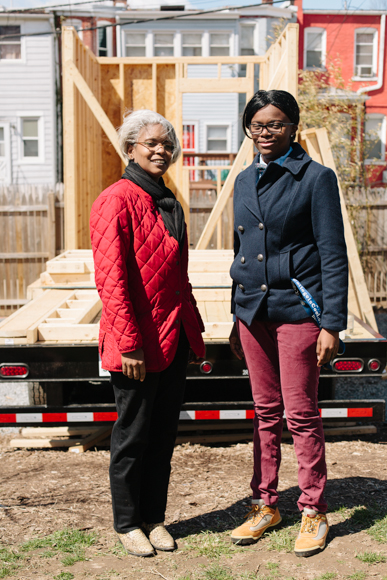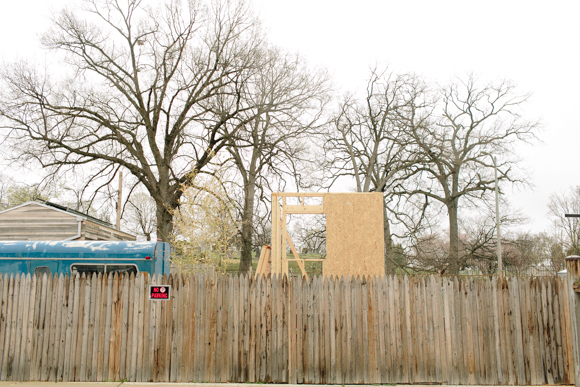They're learning valuable skills, and, as their teacher says, "they understand that [tiny houses] could be the wave of the future."
It’s not exactly legal to live in a tiny house in the District, but that’s not stopping a group of high school students from building one.
Now through the end of school in June, they’ll be erecting four tiny walls and a tiny roof over their 160-square-foot house at the
Micro Showcase lot featuring tiny structures in Stronghold.
The project is not just for show, says Shelly Karriem, director of the
Academy of Construction and Design, a trade school housed at Cardozo Education Campus. The main objective is to teach these students the basics of constructing a building of any size, which could help them prepare for a career in the field or work their way through college.
 Shelly Karriem, director of the Academy of Construction and Design, and her assistant Krystal Boone, a former student of the program, in front of the Academy's tiny house in Stronghold
Shelly Karriem, director of the Academy of Construction and Design, and her assistant Krystal Boone, a former student of the program, in front of the Academy's tiny house in Stronghold“This tiny house movement is sweeping the country, and it just fit with what we needed at the time,” Karriem said.
Tiny or micro houses, loosely defined as primary living spaces measuring less than 400 square feet, have generated
growing interest nationally and in D.C. However, current zoning regulations make houses like the ones at
Brian Levy’s Micro Showcase lot illegal to inhabit full-time.
There’s nothing in the city’s current zoning regulations related to “tiny houses,” Edward Giefer, spokesman for the D.C. Office of Planning, wrote in an email. But structures that would qualify as “accessory dwelling units” — like living in a house-on-wheels behind a friend’s rowhouse — are not permitted in the city.
Karriem says that doesn’t mean the skills her students are building alongside a tiny house won’t be useful — and perhaps a taste of what’s to come for the construction industry.
“They understand that this could be the wave of the future,” she says.
As many as 30 students will have a chance to hammer nails into the tiny house that’s now being constructed at the Micro Showcase site, though no more than six are likely to work on it at once (it is, after all, quite small).
While building the house alongside a professional instructor, the students are weighing which features to include. Should the toilet compost or incinerate waste? Should they power the house with solar panels, propane, or a bit of both? And how could water collection help reduce the environmental impact of those living in the home?
“We’re learning as we go,” Karriem says.
The D.C. Students Construction Trades Foundation, which supports the Academy, owns the house and is funding its construction. Karriem isn’t sure what it will be used for upon completion, but it should remain on display at the showcase for some time.
When the students are not working on the structure, they’re attending classes on carpentry, electrical work or HVAC installation.
Karriem says the project is a practical way for them to hone the skills they’ll use most in a construction setting. The tiny house is decidedly different from their previous project, for which students in the program helped build a single-family home on 13th Street Northwest.
Karriem was considering everything from a dollhouse to another single-family home for the students to construct next when she stumbled upon tiny homes as the perfect compromise. She ordered plans for an 8-by-20-foot structure online, and soon the students were building it in the lab.
But the lab, it turns out, wasn’t quite big enough.
“They didn’t have the space — literally the door height — to construct it inside or in the parking lot. They needed a place to finish it,” says Brian Levy, whom Karriem had met during a visit to his lot while she was researching micro homes.
Levy had recently had
a falling out with the two other tenants who had been part of a Boneyard Studios showcase at the site — so he had the space they needed. (Jay Austen still maintains the
Boneyard Studios name and recently moved his Matchbox tiny house from a backyard in Brookland to another in Ivy City, according to
his blog.)
He says a project that involves young people learning the tiny-house trade fits perfectly into his ongoing mission to demonstrate the possibilities for living small.
“The idea is that this would be a showcase of multiple micro-structures for living or working, all under 350 square feet,” says Levy.

Besides the student house that is being constructed on site this spring, the space features Levy’s original
Minim House, an 11-by-22-foot trailered house that captures rainwater and runs mostly on solar power. Levy also built last year a small
Studio Shed where he can do everything from woodworking to music recording. He also recently started construction in a nearby lot on
Boombox DC, a structure to be built from two shipping containers that will “serve as an inspired space for music, musings and life.”
Levy opens up his lot and the micro buildings on it one Saturday a month for public tours that can bring as many as 100 people to the space. Now, the student house that’s being reconstructed on site is part of that presentation.
Melissa Longano, an architectural designer at Wiencek + Associates, attended one such tour in early April. Her firm is researching off-the-grid homes and how the concepts they contain might be integrated into its affordable and mixed housing projects in the District.
“Because so much of D.C. housing is not affordable and also very large, it was great to see living on a small scale that’s tangible,” Longano says.
As interest in these types of structures grows, Levy hopes that D.C.’s latest revision of its zoning laws, due to be completed near the end of the year, will make more allowances for residents wanting to reduce their living-space footprints.
Even as tiny house enthusiasts wait for a more favorable legal framework, D.C. residents are finding ways to incorporate the concepts of the broader micro housing movement. People interested in building small paid $400 apiece to attend a
“Dream Big, Live Tiny” workshop hosted by the Tumbleweed Tiny House Company in Washington at the end of February.
Perhaps the biggest development on the small-living front in the District is the micro-units now under construction at
The Wharf on D.C.’s Southwest Waterfront. Some of the planned units will range from 330 to 360 square feet and could help pave the way for other developers in the District considering smaller, more affordable and eco-friendly spaces.
With these small-living concepts, Langano says, “Everything you do is more intentional. I think the micro house is a really good start to that conversation.”